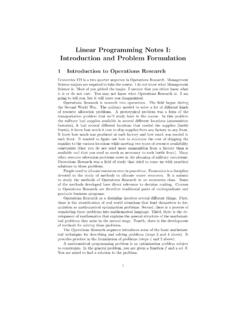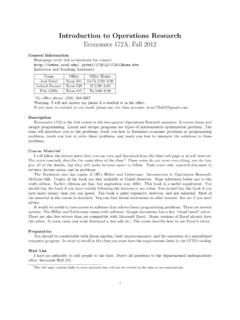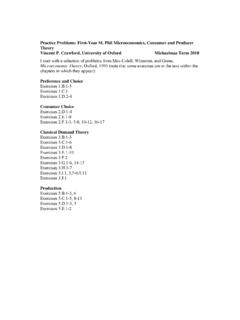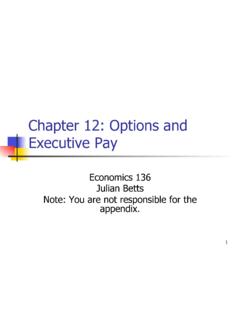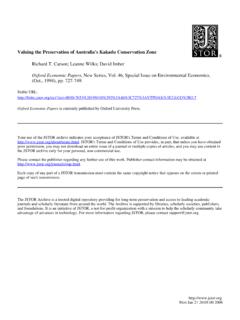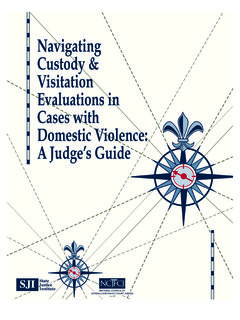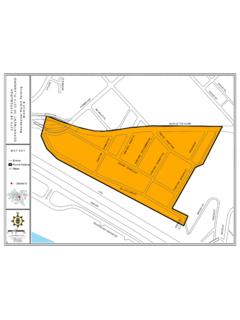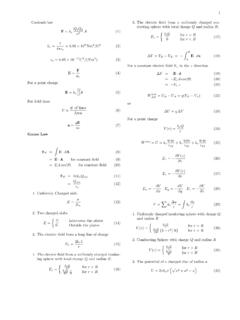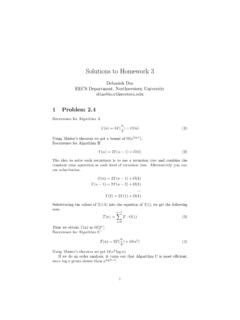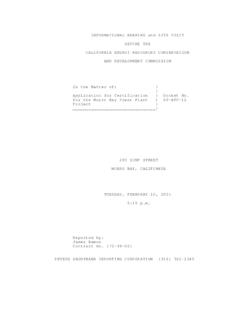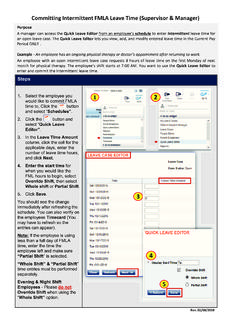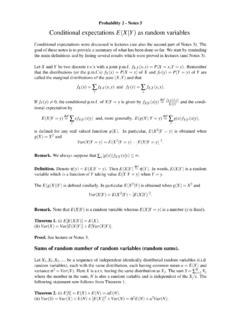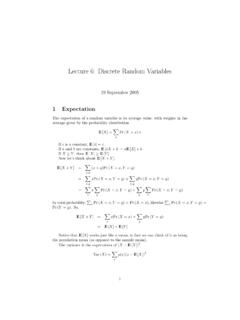Transcription of X Y be two random variables, with means µ and Var(X ) = = …
1 Econ 120A Ramu Ramanathan Spring 2003 Answers to Exam #2 I. Let X and Y be two random variables, with means x and y, Var(X ) = = E(X2X 2) , Var(Y) = = E(Y2X 2Y 2) , and Cov (X, Y) = 2Y XY . Now make the transformations U = X + Y, and V = X Y. (a) (3 points) Derive E(U) and E(V) in terms of X and Y . E(U) = E(X+Y) = E(X) + E(Y) = X + Y E(V) = E(X Y) = E(X) E(Y) = X Y (b) (5 points) Derive E(U V) in terms of X , Y , and . 2X 2Y [Hint: you want the expected value of U times V. Use the definitions at the top of the page.] E(UV) = E[(X+Y)(X-Y)] = E(X2 Y2) = E(X2) E(Y2) Since 2X = E(X2) , we have, E(X2X 2) = + , similarly for E(Y2X 2X 2). E(UV) = + - ( + ) 2X 2X 2Y 2Y (c) (6 points) Derive Cov (U, V) in terms of and only. 2X 2Y Cov (U, V) = E(UV) [E(U) E(V)] = + ( + ) (2X 2X 2Y 2Y X + Y )(X Y ) = + ( + ) ( ) = 2X 2X 2Y 2Y 2X 2Y 2X 2Y (d) (4 points) What is the condition under which U and V will be uncorrelated (that is, have zero correlation) and why?
2 Since uncorrelated means Cov(X,Y) = 0, required condition is = . 2X 2Y 1 II. Let x1, x2, .. , xn be a random sample drawn from a population with mean and variance 2. In other words, E(xi) = , and Var (xi) = 2 for i = 1, 2, .., n., and the x s are all independent of each other. Let ==niixnx11be the sample mean. (a) (4 points) Show that E(x) = .. E(x) = E ( =niixn11) = n1E() = =niix1n1 =niixE1)( = n1 n = It is possible to show that Var (x) = n2 , but you need not prove it. (b) (4 points) Let Z = )( xn. Show that E(Z) = 0. E(Z) = E( )( xn) = nE(x ) = 0 because E(x) = . (c) (4 points) Show that Var(Z) = 1. Var(Z) = E[( )( xn)2] = ( n)2 E[(x )2] = 2 n Var(X ) = 2 n n2 = 1 III. X and Y are random variables with means x and y, variances , and covariance 22andYX XY , all fixed constants. Consider the new random variable U = (Y Y ) b(X x), where b is a fixed constant that I choose.
3 It follows that U2 = (Y Y )2 2b(X x)(Y Y ) + b2(X x)2. [Hint: Do not expand this expression. Keep the terms grouped as they are.] (a) (4 points) Derive the expected value of U. E(U) = E[(Y Y ) b(X x)] = E(Y) Y bE(X x) = E(Y) Y b[E(X) x)] = Y Y b[ x x)] = 0 2 (b) (7 points) Derive , the variance of U, in terms of b, and the covariance 2U 22 ,YX XY . 2U = E[U2] [E(U)]2 = E[U2] because the second term is zero. = E[(Y Y )2 2b(X x)(Y Y ) + b2(X x)2] = E[(Y Y )2] 2bE[(X x)(Y Y )] + b2E[(X x)2] = 2b2Y XY + b2 2X (c) (6 points) Suppose I want to choose b in order to minimize with respect to b, treating everything else as fixed. Derive the value of b that minimizes this variance. [Hint: Your answer will depend only on and 2U XY2X ].
4 BU 2 = 0 = 2XY + 2b or b = 2X 2X XY Solving for b, we get b = XY /. 2X (d) (3 points) Be sure to check the second-order condition also. 222bU = 2 which is positive and hence a minimum is attained. 2X 3
